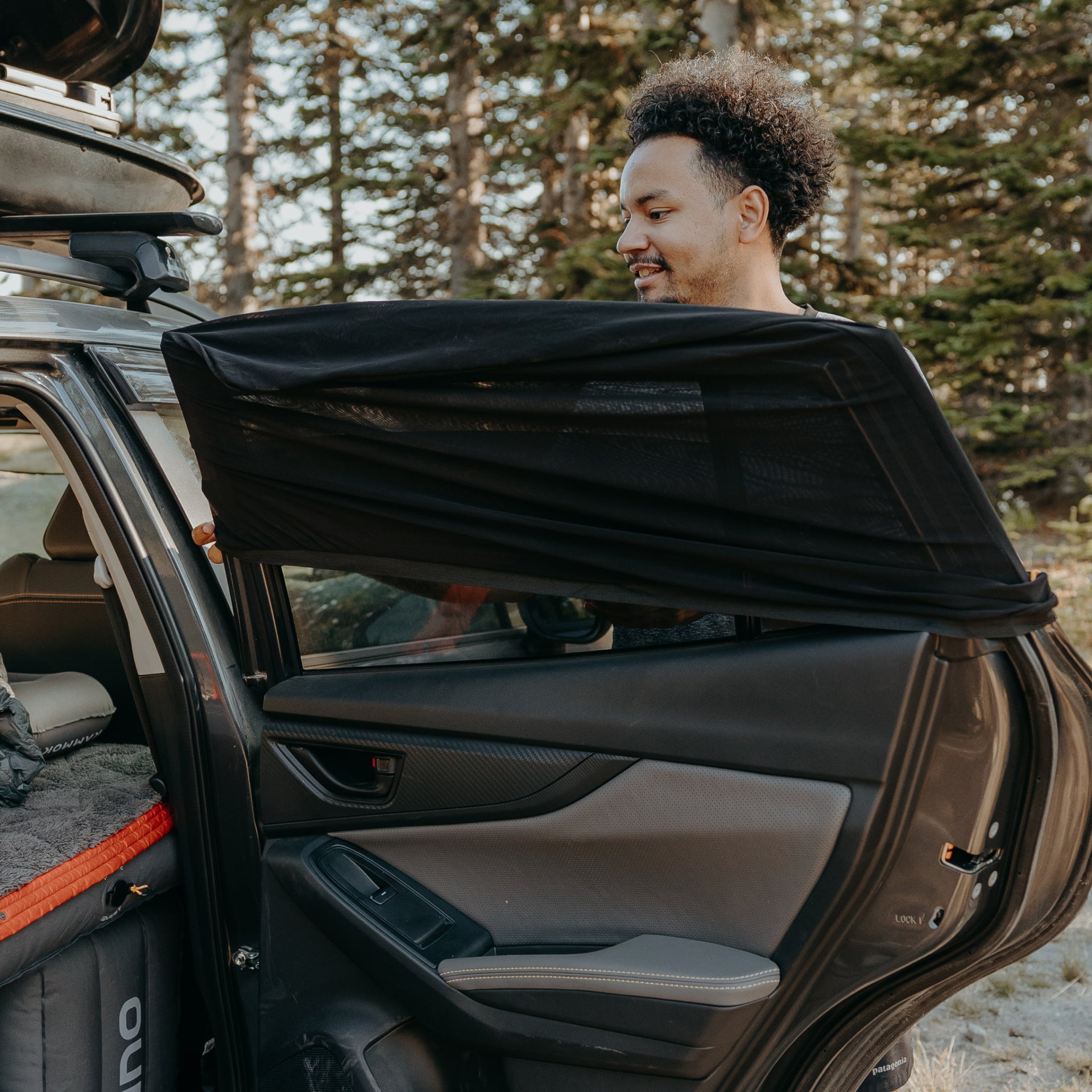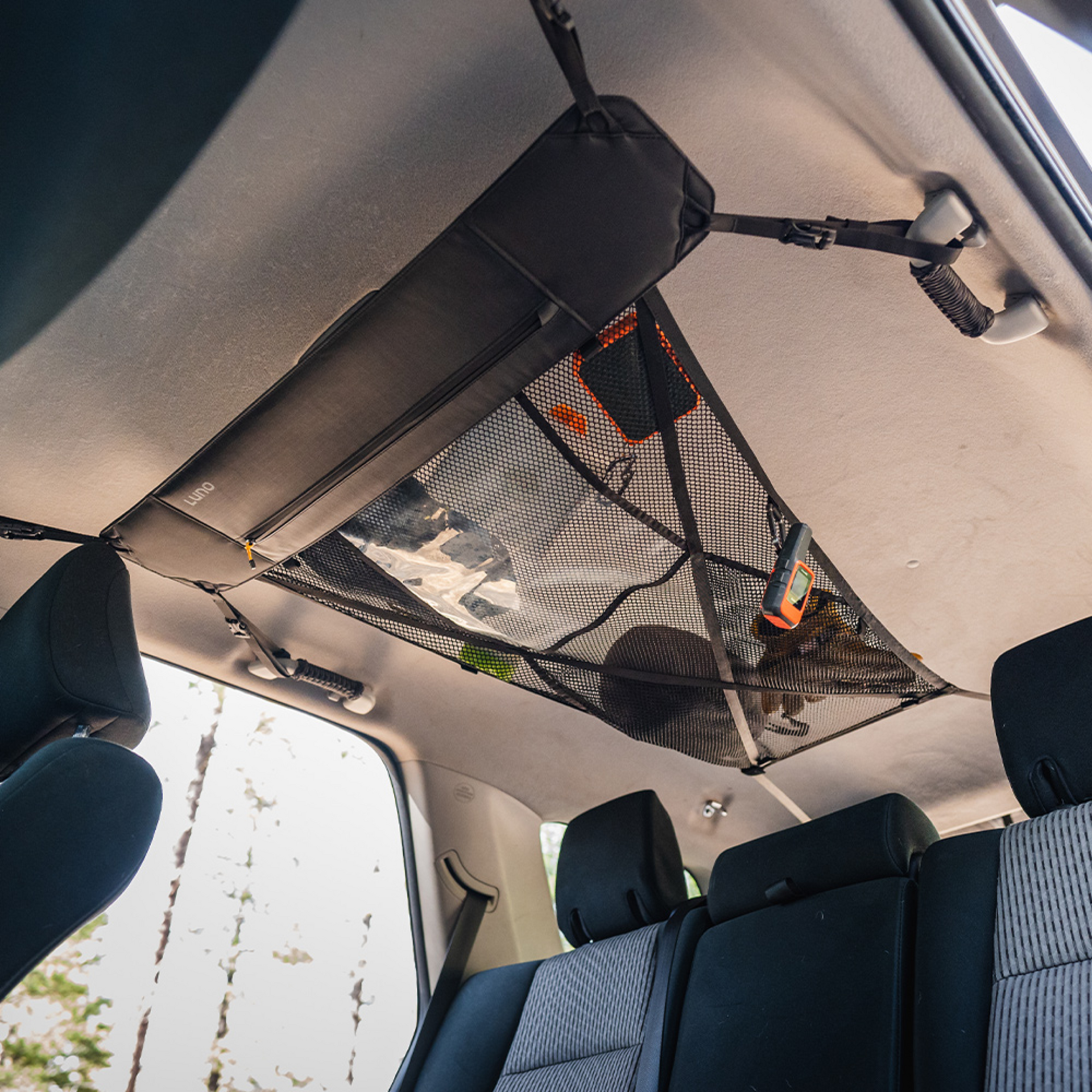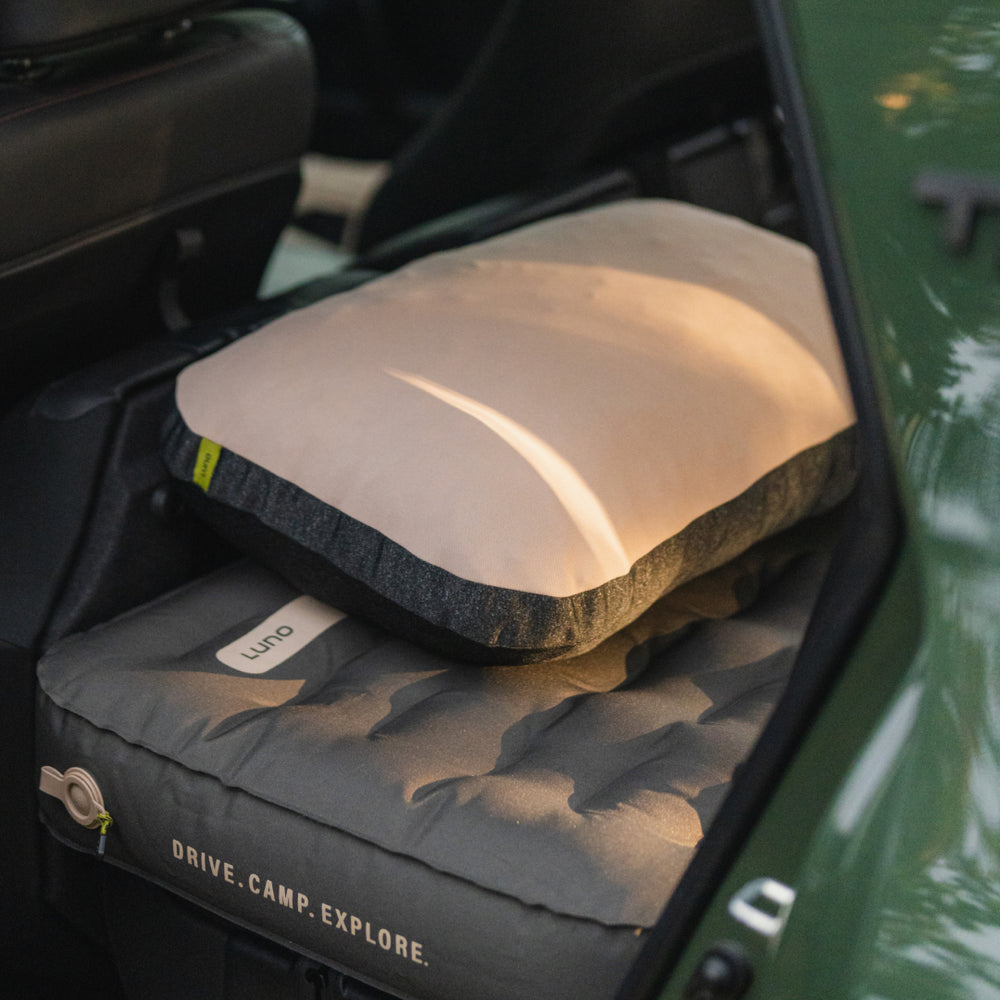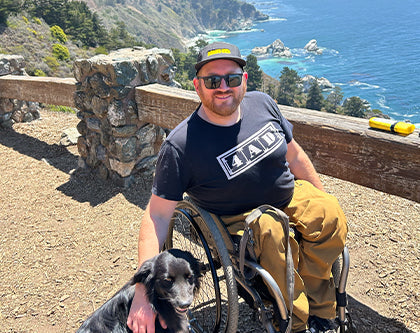
9 Tips for Camping During Peak Wildfire Season
Have you ever seen Smokey the Bear’s comedy special? We haven’t either. That’s because forest fires are no joke. Lighthearted dad jokes aside, this month’s edition of the Luno Journal touches on an important topic that all campers should be aware of: wildfire. Thanks largely to climate change, extreme wildfires are becoming more commonplace. If you love to spend time in wild places like we do, it’s essential that you’re informed on the subject.

In this article, we’re going to do a deep dive on camping during wildfire season. We’ll break down fire-safe camp practices and campfire etiquette to help you get on Smokey’s good side and avoid starting forest fires. We’ll also share wildfire camping tips, including how to track wildfires, how we plan camping trips during wildfire season, evacuation tips, and more. If you’re new to camping—or just rusty on wildfire safety—consider this article mandatory homework.
1. “Wildfire Season” isn’t the same each year
When we talk about “wildfire season,” we’re referring to a period of time when wildfires are more likely to happen.
For instance, southern California’s wildfire season typically runs from late spring into fall, when dry vegetation and notorious Santa Ana winds combine to create dangerous wildfire conditions. However, these dates are based on historical patterns, nothing more. Do you remember the devastating Malibu fires that happened in early 2025? Those occurred in January, way outside of what’s considered “standard” SoCal fire season.
All that to say, while we’re more cautious during “wildfire season,” it’s important to note that wildfire doesn’t follow a Google calendar. Instead, wildfires are a direct result of natural factors, such as weather and wind, and occasionally, human catalysts.

2. Research fire restrictions and guidelines before your trip
We’ve said this before, and we’ll say it again: the vast majority of camping issues can be solved with research before your trip.
Regarding wildfires, it’s essential to check a few things before departing for a camping trip. Namely, are active wildfires currently an issue? Active wildfires can shut down access roads and campgrounds, and, in worst-case scenarios, put you in harm’s way. Additionally, camping in zones with active wildfires, even if it isn’t prohibited, can make you an unnecessary burden on fire and safety crews in the area. Plus, from a sheer enjoyment perspective, camping in the smoke is no fun, and you’ll be coughing like Zoolander after a shift in the coal mines.
Other aspects you want to research ahead of your trip? Fire conditions, fire danger ratings, and campfire restrictions. If the weather is warm and the winds are howling, there’s a good chance that wildfire risk is high and open campfires are prohibited. In higher-risk conditions, even propane grills may be banned. Everyone loves a campfire, but the last thing you want to do is start a wildfire that threatens lives, structures, flora, and fauna
In either case, we’ll share a few tricks and tools we use to research current wildfires and wildfire risk below.
3. Five quick ways to monitor and track active wildfires
AQI Maps
Our favorite way to quickly get a broad picture of wildfires across the country—and across the globe—are AQI Maps. These maps are handy because they’ll give you an understanding of current wildfires as well as the far-reaching impacts of wildfire smoke.
AQI stands for “Air Quality Index,” a numeric value that quantifies air cleanliness from 0 to 500. More specifically, AQI refers to the amount of harmful particulate matter (PM 2.5 and PM10) in the air. Areas with clean air will have an AQI under 50 and closer to zero, and they’ll appear as green on AQI maps. For camping, it doesn’t get better than that.
Yellow is a moderate rating of 51 to 100, but if you’re sensitive to smoke, it can still be uncomfortable to camp in these conditions. Smoke-plagued zones will have AQI values in the hundreds, and they’ll show up as orange, red, purple, or maroon (from bad to worst) on AQI maps. You don’t want to be camping in these conditions, trust us on that one.
One thing to keep in mind? Smoggy cities like Los Angeles or Mexico City can also have poor air quality ratings, even if there are no wildfires in the area.

State Wildfire Resources
Another helpful tool? State wildfire websites that catalog and map wildfires. Not only do these sites help you understand where wildfires are occurring at any given minute, but they’ll provide more insight as far as road closures, evacuation mandates, and more. For instance, here’s the state website that we rely on here in Bend: Oregon’s wildfire response and recovery website. If you’re in the area, be sure to check out the site and consider bookmarking it—it’s a valuable resource. If you call another state home, do a quick Google search to find a similar site for your own region.
Google Search for Wildfire Information
Speaking of search engines, a quick search of “wildfires near *insert destination of choice*” can’t hurt! You can even filter news articles by recent dates, so you are informed on the most up-to-date information and don't accidentally read an article from 3 years ago and think it's current news (speaking from personal experience).
State and National Park Websites
If we’re heading to a specific national or state park, one of the first resources we’ll check is that park’s website. Parks will put any alerts front and center on their websites, especially if visitors aren’t welcome, there’s an active wildfire, or wildfire danger is high.
X (aka Twitter) for Wildfire Updates
Last but not least, X (formerly known as Twitter) is another valuable resource, although not always the first you'd think to check for live updates. We will primarily use X to monitor active wildfires, as people with boots on the ground can provide more timely updates than news publications reporting on wildfires. We’ll even follow hashtags (such as #PalisadesFire) to stay up-to-date on a specific incident. Keep in mind, though, that not everyone on X is verified. For that reason, we make sure to follow and get updates from legitimate accounts like wildfire agencies, fire departments, and other government agencies.

4. Check for local campfire restrictions
If you’re camping at a state or national park, check the park’s website for fire restrictions leading up to your trip. The same goes for BLM land, National Forest Service sites, and other public lands. We like to do this ahead of our trip, as we’ll pack accordingly if campfires are in the cards.
You can—and should—also check for signage or ask a ranger or park employee upon arrival, as regulations can change daily.

5. When in Doubt, Avoid Campfires Completely
Not sure if campfires are permitted or prohibited? We’ve got you.
If you can’t find any information online, can’t reach a park employee by phone, and don’t see any signage on your way into the wilderness, our advice is to forgo campfires completely. Sure, it’s a bit of a bummer to skip a campfire if you’re wrong. But the upside of a mistake is minimal, while the downside, starting a forest fire, is tremendously grave.
Long story short? If you’re ever in doubt, chicken out.
📍Pro-Tip: Check to see if propane fires are allowed in a burn ban area. Sometimes, gas firepits and stoves are still permitted and don't require use in a designated fire pit. Most importantly, check your regulations.

6. Practice Leave No Trace campfire safety principles
If you’ve got the green light to have a campfire, wonderful! But the safety protocols don’t stop there. It’s important to follow Leave No Trace campfire safety principles in order to both address wildfire hazards and mitigate your impact on the environment.
We encourage you to learn more about Leave No Trace’s campfire creed here, and to check out all seven of the organization’s principles here, but here’s the basic campfire info you need to know:
- Follow any local regulations: Check in with rangers or park employees and ensure you’re closely following all local regulations.
- Use existing fire rings: Fire rings can help protect your fire from wind and keep embers from sparking a wildfire. Using an existing ring instead of creating a new one helps minimize your impact on the campsite. If you aren’t using a fire ring, be sure to use a fire pan or pit.
- Bonfires are an unnecessary risk: No need for a towering, out-of-control bonfire with slow-burning logs. Instead, keep your campfire on the minimal side with easily breakable sticks, so you can manage it as needed.
- Burn and extinguish all fuel: Wait until the fire has burned through all the fuel before heading to bed. And before you hit the hay, use ample water to thoroughly extinguish any smoldering embers.
- Never leave a fire unattended: This is a classic tip that’s self-explanatory. Never leave a fire unattended. It’s important you’re on hand in case the wind picks up or a wayward ember sparks a flame outside of your fire ring.

7. Don’t choke on smoke, and don’t be afraid to pivot a trip
Remember those AQI maps we mentioned above? Those maps are crucial when planning a camping trip during wildfire season. Even if you’re far from the flames, smoke and poor air quality can dampen even the most epic adventure.
Our advice? Use AQI maps and forecasts to check your destination of choice before you head out. If smoke seems like it might be an issue, don’t chance it. Avoid orange, red, and purple zones on the map and pivot to cleaner, greener pastures.
9. wildfire evacuation tips
If you do find yourself in the unfortunate situation where you’re camping near a wildfire, here are a few important evacuation tips.
-
Stay informed. If you have cell service, check the websites of local government agencies. Follow anyone who might announce an evacuation order or other important information on X (say, @CalFire if you’re in California) and enable notifications.
-
Listen up. Heed any and all warnings and evacuation mandates, whether they’re from a park ranger in person or a government agency on your phone.
-
Don’t panic. Stay calm and collected, but move quickly.
-
Don’t wait. Wildfire can progress at startling speeds. If anything, make moves earlier rather than later, even if it might seem a little premature.
- Exit strategy. Check evacuation routes for road closures before you head out, if possible.
10. Locations less prone to wildfires and how to find them
Sadly, no wilderness destination is immune to wildfires. In this day and age, even sparsely vegetated zones like the Mojave Desert and Sonoran Desert are affected by these powerful natural disasters. We wish we could suggest a list of fire-proof destinations to help you camp safely and confidently this wildfire season, but to do so would be disingenuous and dangerous.

Fire Safety First
Look, we know this isn’t the most fun article we’ve ever posted. It’s not even in the top 100. However, it’s one of the most important stories we’ve shared with our Luno community, because safety really does come first. We want to protect both our fellow campers and the wild places we play in, and sharing information on wildfires is a great way to do just that.
To wrap up, the best advice we can offer is this: do your research ahead of each camping trip. By using maps and local resources to determine if wildfires are active or there’s a high risk of wildfires, you can both camp more safely and minimize your impact on the landscapes we love.
Thanks as always for reading, and we’ll see you on the road.
–The Luno Crew










